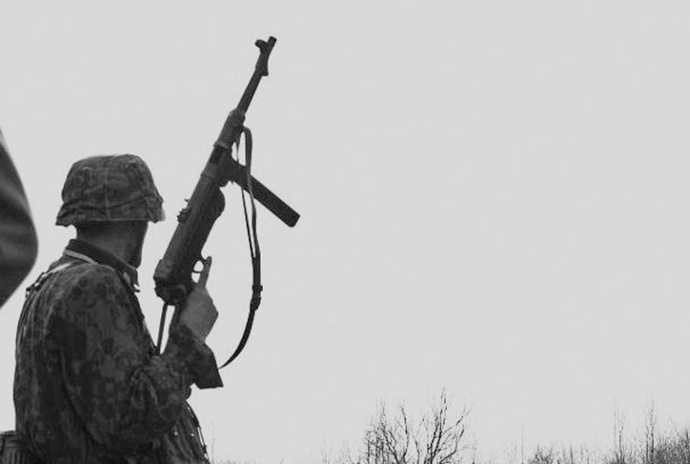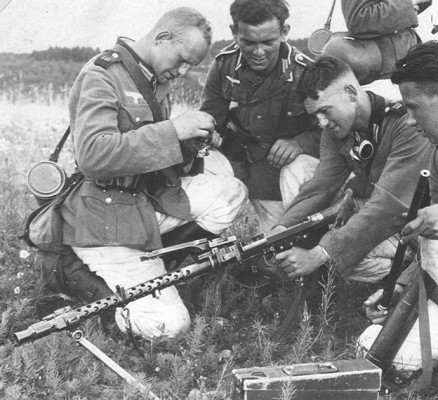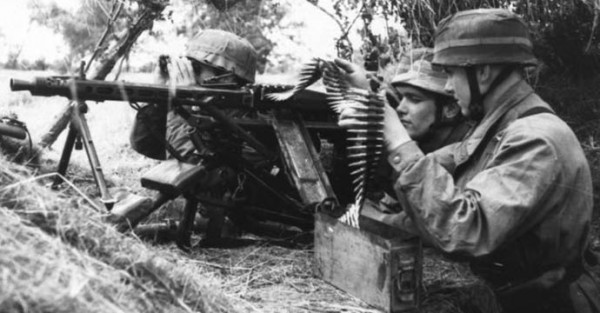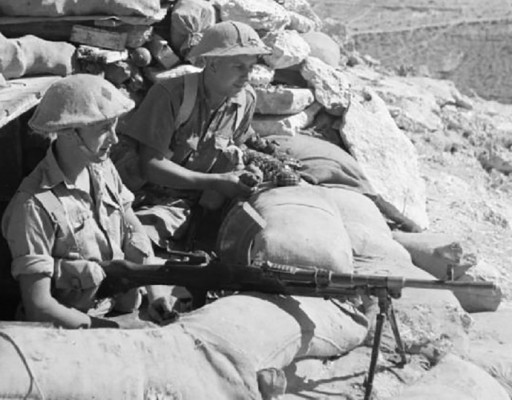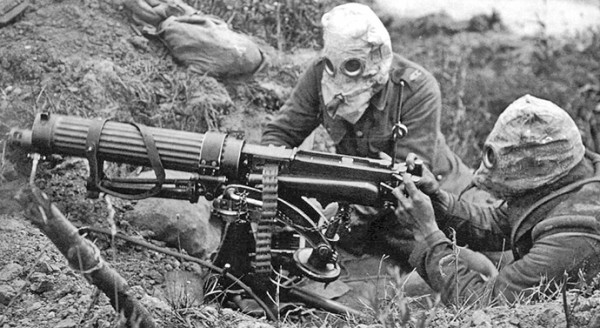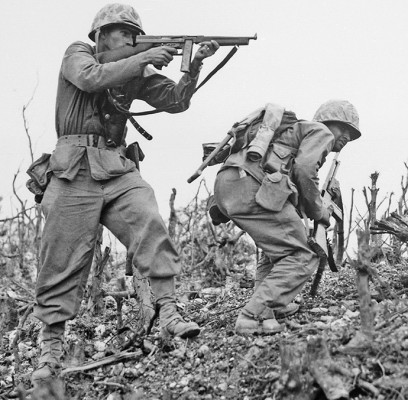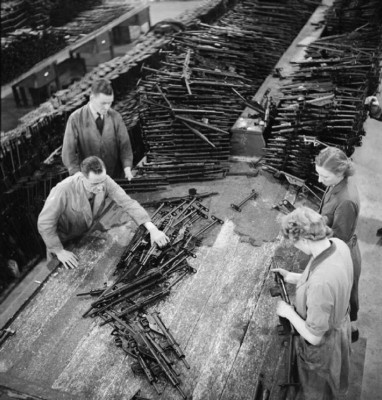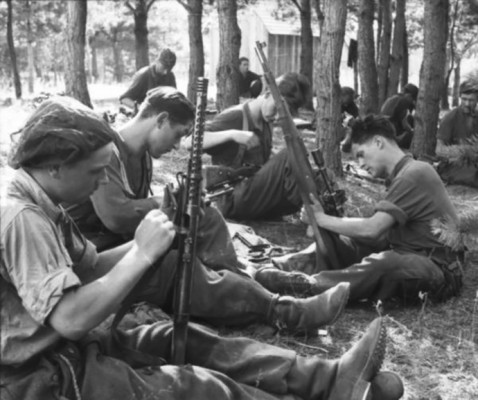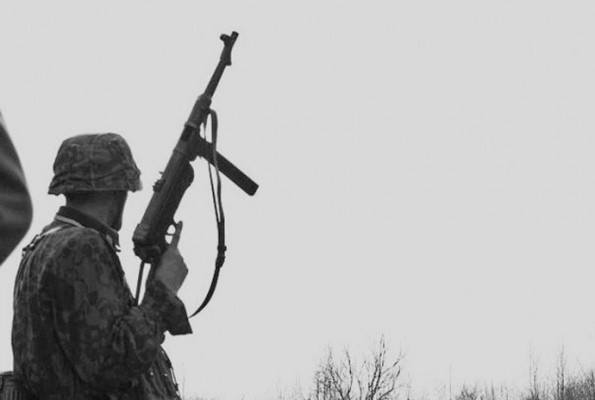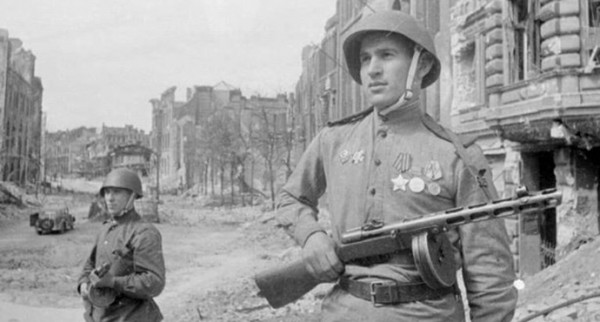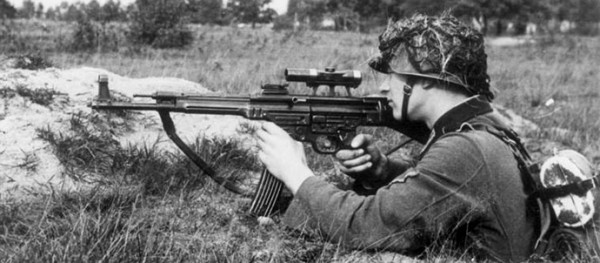The Gatling gun was first developed in Chicago in the mid-19th century and, although it was not truly automatic at that time, became a weapon that would change the nature of warfare forever. Machine guns were used to devastating effect in World War One and were a major contributor to the emergence of stalemate, with annihilation the prospect for any army that exposed itself on the open battlefield.
By World War Two machine guns were more mobile and adaptable weapons, whilst sub-machine guns gave infantrymen far greater potency at close quarters. They were also fitted to tanks and aircraft, although became less effective in these roles as armour plating improved. The machine gun therefore went from determining the static tactics of attrition used in World War One to being a fundamental part of the mobile tactics more common in World War Two.
1. MG34
The German MG34 was an efficient and manoeuvrable gun that could be mounted on a bipod or tripod depending upon the situation. It was capable of automatic (up to 900 rpm) and single-round shooting and can be seen as the world’s first general purpose machine gun.
2. MG42
The MG34 was followed by the MG42 light machine gun, which could fire at 1550 rpm and was lighter, faster and produced in far greater numbers than its predecessor. This was probably the most effective machine gun produced during the war.
3. Bren Light Machine Gun
The British Bren light machine gun (500 rpm) was based on a Czech design and introduced in 1938. Over 30,000 Bren guns were produced by 1940 and they proved to be accurate, reliable and easy to carry. The Bren was supported by a bipod and offered automatic and single-round shooting.
4. Vickers
The British Vickers (450-500 rpm) machine guns were, along with American M1919s, the most reliable of the war across all environmental contexts. The Vickers range was a remnant of World War One and models were still being used by the Royal Marines during the 1970s.
Handheld sub-machine guns became integral to urban conflict conducted at close quarters in World War Two.
5. Thompson
True sub-machine guns were brought to prominence by the Germans in 1918 with the MP18, which was later developed into the MP34 and the Americans introduced the Thompson soon after. Arriving after the end of World War One, Thompsons were used by the police from 1921. Ironically, the ‘Tommy Gun’ then became synonymous with gangsters in the USA. In the earlier part of the war the Thompson (700 rpm) was the only sub-machine gun available to British and American troops, with simplified design allowing mass production. Thompsons also proved to be ideal weapons for the British commando units newly assembled in 1940.
6. Sten Gun
In the longer term the Thompson was too expensive to import in sufficient numbers for the British, who designed their own sub-machine gun. The Sten (550 rpm) was crude and susceptible to fracture if dropped, but cheap and efficient. Over 2,000,000 were produced from 1942 and they also proved to be a key weapon for resistance fighters across Europe. A silencer-equipped version was also developed and used by commando and airborne forces.
7. Beretta 1938
The Italian Beretta 1938 (600 rpm) sub-machine guns are similarly iconic to the American Thompsons. Although factory produced, a great deal of attention to detail was afforded to their assembly and their ergonomic handling, reliability and attractive finish made them prized possession.
8. MP40
The German MP38 was revolutionary in that it marked the birth of mass production in sub-machine guns. In stark contrast to the Berettas, plastic replaced wood and simple die-cast and sheet-stamping production was followed by basic finishing. The MP38 was soon developed into the MP40 (500 rpm), in which guise it was produced in great numbers using local sub-assemblies and central workshops.
9. PPSh-41
The Soviet PPSh-41 (900 rpm) was essential to the Red Army and crucial to driving the Germans back from Stalingrad during and after that fateful battle. Following a typical Soviet approach, this gun was simply designed to facilitate mass production and over 5,000,000 were produced from 1942. They were used to equip entire battalions and were ideally suited to the close urban conflict for which they were required.
10. MP43
The German MP43, renamed by Hitler in 1944 as the StG44, was developed to combine the accuracy of a rifle with the power of a machine gun and was the world’s first assault rifle. This meant it could be used both at distance and close range and variations on this model such as the AK47 became ubiquitous in the warfare of future decades.
By Simon Parkin
History graduate (and enthusiast) with postgraduate degrees in environmental history and heritage science.
